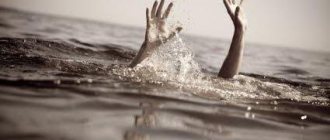Hydrophobia - fear of water, was described in past centuries. This is a fairly common phobia of children and adults. A person cannot respond adequately to a glass of tea, rain outside the window or large bodies of water. An irrational fear of water causes panic, adrenaline rush and other physical symptoms. People susceptible to this phobia cannot live a full life, because water makes up 70% of our body, it is everywhere and is simply necessary for humans.
What is hydrophobia
Aquaphobia is characterized as having fear at the sight of water, the mention of it, or even the thought of it. It occurs as a reaction to psychological trauma.
Psychologists write about the name of a phobia - fear of water. Official name: hydrophobia or aquaphobia.
Fear provokes vegetative-vascular reactions. So, a patient, seeing a filled bath, may experience dizziness and a panic attack. An incorrect reaction of the brain gives a protective reflex: adrenaline is released into the blood, which helps to escape from danger. The heart begins to beat faster, the pressure rises.
Symptoms of aquaphobia include: cold extremities, trembling in the body, rapid breathing. There may be a feeling of lack of air, tingling in the arms and legs. Discomfort can occur without contact with water, but only at the thought of it. The brain does not need to receive a picture or contact; it is enough to give a signal that “danger is approaching” and a reaction will appear.
Symptoms and manifestations of hydrophobia
“I’m afraid of water” - many may say so, but not every person has hydrophobia accompanied by unexpected panic attacks. With hydrophobia, fear is accompanied by pronounced vegetative-vascular reactions.
When fluid appears, the following symptoms may develop:
- severe dizziness;
- increased blood pressure;
- accelerated heartbeat;
- coldness and trembling of the extremities;
- suffocation, feeling of lack of air;
- convulsions;
- chills;
- increased sweating.
Moreover, these vegetative-vascular manifestations can occur not only while swimming in water or walking along the shore, but also at the mere mention of a body of water.
Features of manifestations in children
The symptoms of hydrophobia in a child are not much different from a neurotic disorder in adults. He refuses to go into the water; before bathing, the baby is seized with panic, accompanied by crying, anxiety, and hysterics.
We recommend reading: How to stop being afraid of the dentist - effective recommendations
To “get acquainted” with the pond, parents do not need to force the child to enter immediately. You should accustom him to water gradually, in a playful way - for example, by watering him from a watering can on the shore.
You can enroll your child in a swimming pool, take water aerobics courses, or simply take your child to a water park. Parents should talk to him about his fears and explain that they are completely groundless. You can also show bright, colorful pictures and cartoons with the inhabitants of rivers and seas, and talk about them in a positive context.
In adults
Hydrophobia significantly worsens a person’s life - he loses the opportunity to enjoy a good rest at sea, he has difficulties with daily hygiene procedures, even banal hand washing or washing turns into stress. Very often, against the background of a neurotic disorder, hostility and aversion to various drinks develops.
At the sight of water, the hydrophobe feels a rapidly growing panic and tries to run away and hide from danger as quickly as possible. These manifestations may be accompanied by confusion and inability to navigate in space.
Hydrophobia, accompanied by a fear of rivers, seas and oceans, does not interfere with most patients in everyday life, but it imposes serious restrictions on recreation and leisure activities.
In a severe form of phobic disorder, an attack of fear can be triggered by ordinary things - tap water, a bath, taking a shower. This leads to non-compliance with personal hygiene standards and as a result of social maladjustment.
Types of disorder
The forms of hydrophobia differ, since water is a multifaceted substance. Some may be afraid of rain. Someone is afraid to be near the seashore, but feels calm in the bathroom. And there are people for whom even tea in a mug causes fear.
Forms of hydrophobia:
- Chionophobia is a manifestation of the fear of ice or snow. The reaction is caused by water in a solid state. Quite a rare occurrence.
- Thalassophobia is the fear of the open sea, the ocean. Often occurs in children who read fairy tales about sea monsters.
- Ablutophobia is the fear of medical procedures involving water.
- Bathophobia is the fear of large volumes of water: lakes, rivers and oceans. Occurs due to a traumatic situation.
The forms are different, but the symptoms are similar.
Causes of fear of water
The cause of hydrophobia is most often psychological trauma. This could be an unpleasant event that happened during rainy weather. Hydrophobia often occurs in people who, under certain circumstances, have drowned or fallen through the ice. A phobia of water can be associated with medical procedures where water is present: enema, injections. If the enema caused pain, another time even the sight of it will cause a panic attack in the child: ablutophobia.
When people witnessed others drowning, someone being drowned, this also becomes the cause of aquaphobia. Any negative events that occur in water cause an association with it.
Example. They tried to drown the girl. She is afraid of water and does not bathe anywhere except in the shower. Fear is devoid of logic because it is irrational. The water is not a threat, it was the person who tried to harm it. But it is water that the girl is now afraid of. He can calmly look at his ill-wisher, but he doesn’t come close to the water. This is the peculiarity of the work of the psyche.
In psychological practice, there have been cases when a person, having choked, began to be afraid of the water in the mug. At the same time, he calmly swims in the sea. Theoretically, even if a girl breaks up with a guy while swimming in the river, this could provoke hydrophobia in him.
Non-psychological cause of phobia
Hydrophobia is also a sign of a deadly disease - rabies. This is often how animals that are sick are tested: if they drink water, they don’t have rabies.
Hydrophobia due to rabies occurs when the brain is damaged by the virus. It is so powerful that a person begins to shake if he is near a glass of water or sees a drop on the table. Convulsions and panic begin. Patients with rabies are isolated and kept in rooms without even heating pipes. The sound of water can also provoke such a reaction.
Remember! Rabies is incurable.
It occurs upon contact with sick animals. More likely - through contact with his blood or a bite. If you are bitten by an animal - it doesn’t matter whether it’s a fox, a rabbit or a domestic cat, you need to go to the hospital. There are only a few days for this.
Causes of phobia
The main reason for the development of panic fear of water is the psychological trauma associated with it - accidents on reservoirs, falling through ice, unpleasant, sad events that occurred during the rain.
Common causes of hydrophobia:
- A child may feel a panicky fear of water after unsuccessful attempts to learn to swim.
- In an adult, the fear of drowning develops after an accident on the water or after seeing a drowned person.
- In children and suspicious people, hydrophobia can be caused by watching water-related disaster films.
- A common cause of panic attacks is a sudden fall into the water by a person of any age who does not know how to swim.
- Fear of fish, crustaceans and other inhabitants of water bodies.
- Incorrect bathing of the child, too fast or sudden immersion in water.
Hydrophobia can develop against the background of painful, unpleasant sensations that arise from contact with water - after frostbite, choking on water.
How to recognize hydrophobia
If your child cries every time in the bathroom, he probably has some degree of hydrophobia. If the child is already talking, you can ask him about fear. If not yet, just watch the reaction.
An adult can recognize hydrophobia by the following signs:
- an attack of fear begins in front of a certain type of water;
- every time the thought of going to the bath or the beach causes an unpleasant reaction;
- if you have had traumatic situations in the past related to water, this is a contributing factor, a predisposition;
- Sometimes I have dreams about someone drowning.
Only a specialist can make an accurate diagnosis. If a person does not have a physical factor, vegetative-vascular manifestations of aquaphobia, then it may not exist. Or it occurs in a mild form. You can find anything on your own: most often people make mistakes because they don’t see the full picture. To figure out whether the disease is present, you will have to contact a professional psychotherapist or psychologist.
How to get rid
Before learning to swim, it is common for adults and children to be afraid of bodies of water. This occurs due to the inability to control the elements. Learn to swim, feel that the water element can be subdued a little, then the fear of water will quickly pass. However, people often complain: I’m afraid to learn to swim, I’m afraid to drown, etc. To make contact with water as comfortable as possible, choose a calm body of water in some picturesque place for your first swimming lessons. To begin with, you can simply relax several times on the shore of a beautiful lake, pond or river.
A parent should help the child during bathing, calming him down and setting him up for positive emotions. Adults can take a friend or relative with them who is a good swimmer. A close person and a reliable swimmer is nearby and will provide moral support and help in case of an unforeseen situation. Your fear of water will immediately become much less.
If you are afraid to even approach a body of water, you cannot do without psychotherapy. A popular method is to “feel” fear. During therapy, the patient imagines himself entering a pond, swimming and bathing. Moreover, this process must certainly be accompanied by positive emotions. Through such a virtual experience of phobia, real water scares a person less.
Of course, an aquaphobe can simply avoid bodies of water, not go to the sea or relax on the coast. However, people who are afraid of swimming deprive themselves of great joys in life. In addition, aquaphobia, which is not treated, often takes on a complex form when a person not only refuses sea cruises, but stops skiing, walking in the snow, experiences severe stress during a thunderstorm, is afraid to take a bath and even drink water. Symptoms of severe cases of aquaphobia include:
- fear of water in any of its manifestations - swimming in a bath, pool, open reservoir, getting caught in a downpour, etc.;
- anxiety before drinking liquid from large containers;
- discomfort upon contact of any liquids with the skin;
- when thinking about swimming, dizziness, nausea, headache begins, and blood pressure rises;
- When entering a body of water, convulsions, panic attacks, and loss of consciousness occur.
You can stop being afraid of water in advanced cases only with the help of a good psychotherapist. A specialist will determine the type of aquaphobia, identify its cause and determine a strategy for getting rid of fear. Most often, two methods of combating hydrophobia are used in practice - hypnosis and the contact method. Hypnosis is excellent at identifying and eliminating children's fears. When using the method of contact with the object of fear, the patient gradually changes his attitude towards the phobia and gets rid of the fear of water.
Hydrophobia in children: how to help a child overcome hydrophobia
The fears of young children are deep, to the point of despair. The child does not have a complete picture of the world. If an adult can understand the bias of his fears, then a child’s fear is similar to that of an animal, primitive. Therefore, children's fears almost always develop into mental disorders: hypochondria, OCD, neurosis.
The best option is the help of a psychologist. This will bring the fastest results. Another option: help your child cope with the problem yourself.
- Explain that this fear is temporary and will soon pass.
- Replace fear with positive emotions every day.
- You can show pictures of children frolicking in the water, show the inhabitants of the underwater world. Cartoons and documentaries that show water in a positive light.
- Show that the water is not dangerous.
- Teach swimming so that the child can see with his own eyes that the water is safe. Just do this carefully so as not to cause a panic attack. Only if the child agrees to try.
The main thing is to do no harm. Hydrophobia is a complex disorder. And it is better to consult a psychologist. If you are unable to attend an appointment, you can always call the helpline. There are toll-free psychological help numbers in every city. There, a qualified psychologist will tell you what parents can do on their own in each specific case. For one child, swimming in the pool will serve as a way to get rid of hydrophobia, while for another, a more severe form of the disorder may begin. Everything is individual.
Treatment methods
A person suffering from hydrophobia definitely needs to consult a psychotherapist. Treatment of a neurotic disorder involves the use of effective methods of psychotherapy. Drug therapy is used extremely rarely, since the phobia does not constantly bother the patient, but is aggravated only by the sight of water.
Psychotherapist
Effective psychotherapeutic techniques allow you to get rid of hydrophobia and panic fear of water.
Most often used:
- Cognitive-behavioral psychotherapy allows you to eliminate subconscious attitudes and change a person’s thinking, tuning him to an adequate perception of bodies of water.
- Modeling situations - discussing with a psychotherapist the causes of panic fear, visiting indoor pools, gaining confidence that the water does not pose a potential danger.
- Hypnotic therapy acts directly on a person’s subconscious, allowing you to get rid of existing fears.
We recommend that you read: Fear of holes and a large number of holes
Art therapy is used to treat hydrophobia in children. Sessions are conducted in a playful way, the child draws his emotions, and then studies them with a psychotherapist. It is considered one of the most effective methods of treating hydrophobia.
Self help
Independent methods of treating hydrophobia can only be used for adult patients; such methods can only frighten children and aggravate the course of a neurotic disorder.
One of the most effective ways to overcome hydrophobia is to learn to swim . For this purpose, it is best to sign up for a swimming pool and trust an experienced trainer. If the feeling of fear is very strong, it is best to start self-medication with group water aerobics or visiting a water park.
To relax, it is very useful for a hydrophobe to do meditation, breathing exercises, and yoga. This will help you achieve relaxation and learn to control your feelings and emotions.
This is interesting:
How to overcome the fear of driving a car for a beginner and not be afraid to drive.
How to stop being afraid of the dentist - effective recommendations.
How not to be afraid of childbirth and overcome the fear of pregnancy.
Features of hydrophobia in adults: how to live with hydrophobia
The fear of water has its consequences. The person seems to be physically healthy, but the disorder prevents him from living normally.
- When friends' holidays are held at a water park, you have to come up with reasons for your absence.
- The man doesn't go to the beach.
- Constantly or periodically faces panic attacks and vegetative-vascular manifestations of phobia.
- Taking your own child to the pool and teaching him to swim is also a problem.
Any phobia limits us. And hydrophobia completely interferes with living a normal life, because water is everywhere: bathroom, kitchen, bathhouse, refrigerator. Hospital, store, fountain near the house. Aquarium. Huge puddles after rain. Autumn showers. Snow and ice 4-5 months a year. You yourself are made of water. And without it there is no life, water is life. And it is simply necessary to develop a normal attitude towards it.
How to treat a fear of water
Phobias are treated with psychotherapy. There is no need to be afraid of this word. Psychotherapy is a conversation with a person who understands the mechanisms of the psyche. He will help you find the cause of fear and eliminate it. It's like finding and untying a knot inside. The psyche will no longer react to water as a danger.
In addition to psychotherapy, sedatives are used to alleviate the condition. These may be mild herbal sedatives or antidepressants. Depends on how strong the fears are.
Remember: phobias are not healthy. Adrenaline, constantly released into the blood, undermines health. The heart and blood vessels weaken. And overcoming fear is a necessity.











